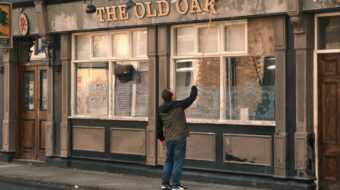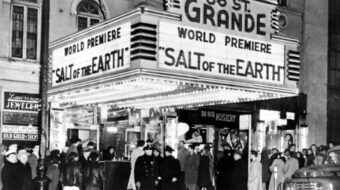TALLMANSVILLE, W.Va. — Working hard, playing by the rules, living your faith and building community can be fatal when mining coal in the Sago Mine, cited last year over 200 times for safety violations and generating $15.7 million for the International Coal Group (ICG) through the third quarter of 2005.
After a 40-hour vigil, hundreds of family members, neighbors and miners from other mines at first heard that 12 of the 13 miners trapped inside the Sago Mine were alive. Based on information from ICG, West Virginia Gov. Joe Manchin confirmed the report.
But hours later, joy turned to horror and then anger early Jan. 4 when Ben Hatfield, ICG’s CEO, announced that 12 miners were dead and the one survivor — Randal McCloy, 27 — was in critical condition. Saying the company was sorry, Hatfield offered no explanation for the wrenching “mistake.”
The first shift of coal miners was just going into the mine on the morning of Jan. 2 when an explosion, felt two miles away, ripped through the underground mine. Trapped, besides McCloy, were Fred Ware Jr., 59; David Lewis, 28; Jack Weaver, 52; Jim Bennett, 61; Alby Martin Bennett, 50; Terry Helms, 50; Marshall Winans, 49; George Hamner Jr.; Martin Toler, 50; Jerry Groves; Randall Simpson and one of their co-workers — 13 miners in all. ICG has refused to release the names of the trapped miners. The partial list is based on interviews and press reports.
A second crew of six miners barely escaped the blast.
Miners rushed to rescue the trapped men but were turned back by toxic gas.
Volunteer fire companies from the surrounding communities rolled onto the site. Rescue workers pulling truckloads of equipment soon joined them and caravans of trucks and drilling rigs continued all day Tuesday.
Phil Smith, communications director with the United Mine Workers of America, told Workers Independent News that UMWA rescue teams and safety experts were at the scene. “Certainly our prayers and our hopes are with the families,” he said, before the bad news came.
Late Monday, rescue teams were finally able to enter the mine and begin their search. A robot preceding rescue workers to monitor air quality got bogged down in the mud inside the mine.
Families and friends from around this rural region gathered in the Sago Baptist Church, right across from the mine entrance, vowing to stay until they saw faces of their loved ones. With dignity, families clustered, sharing stories, their favorite play in the West Virginia University victory in the Sugar Bowl the night before and watching the army of media that descended on their community.
Gov. Manchin, whose uncle died in the 1968 Farmington, W.Va., mine explosion that took the lives of 78 fathers, brothers and friends, kept vigil with the families.
Nick Paglia of Stewardsville, Ohio, a 10-year veteran of underground mining and rescue worker, drove in to volunteer. “I prayed and God gave me the strength to drive down here,” he said, his gaze never straying from the mine entrance, hoping for a sign, a signal that the miners were safe. “I do believe that something should have been done ahead of this. With all those safety violations — some of them only have a $200 fine. That’s not correct. We need stiffer fines to force these [coal] operators to think about people’s lives. I also believe a union would help. Right now, a miner doesn’t have a leg to stand on. If you open your mouth, without a union, you have no back up.”
Sago Mine is nonunion. A tangled web of bankruptcies, new ownership and a series of National Labor Relations Board rulings going back to the Reagan administration have forced miners to work underground without a union contract.
The Mine Safety and Health Administration (MSHA) told the Charleston Gazette that in 2004, the Sago Mine reported an injury rate three times higher than similar mines across the country. In 2005, the agency found 208 violations, fining the company $24,000 so far. The company has paid $14,500 of the $24,000. In the last six months, a dozen roof falls have occurred inside the Sago Mine. In the last three complete inspections, MSHA inspectors wrote up 180 violations and assessment of those fines is pending.
Mary Newton, her husband and brother were standing together watching, listening for word about her former husband, Terry Helms. “We’ll stay here until I see his face,” she said. “This may sound funny with all the rain and mud, but it is really warm here,” she said. “The families, communities, people make it possible to deal with this. Keeps you from shaking. Most are sleeping in their cars or in the church. No one is leaving and more are coming in. It is so terrifying. The people make it possible to survive.”
Helms, a 32-year veteran of underground mining, was later found to be among the dead.
Buckhannon, population 8,000, is just up the road from Tillmansville. All through town businesses replaced holiday greetings and “Go Mountaineers” signs with “Pray for our miners.” Kandas Queen manages the Kroger grocery store. “Everybody has somebody who works in the mine,” she said. “Uncles, brothers-in-law, fathers — it is our life, our roots. My dad worked in the mines. We fed about 50-60 rescue workers and Red Cross volunteers Monday night at the armory. They said they needed over-the-counter headache medication and we brought it. My zone manager is in the store now making soup. For as long as it takes. It is not about money or customers. It is about taking care of your neighbors.”










